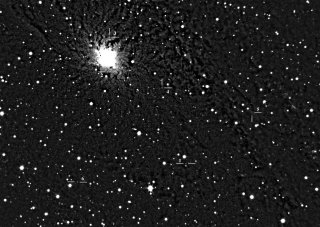|
Kamil focuses his effort to discoveries and following photometry of
novae in the M31 galaxy in Andromeda these times. The number of novae
discovered in M31 by him currently surpassed all other amateurs as
well as professionals.
Preparing to observation (left) G2-1600 CCD camera on
35 cm (13.8 inch)
f/4.7 Newtonian telescope (right) Thanks to his fame, Kamil has access to images captured by
world-class, multi meter telescopes. It is curious that careful
analysis of these images can lead to many new discoveries—tenths of previously overlooked novae was discovered
also in images of M81 galaxy in Ursa Major, no matter that this galaxy
is more that 4 times more distant (about 12 millions light years) than
M31.
The real treasure is the following image of “fireworks” in
M31 galaxy. There are 6 novae captured on single frame, 5 of which
were discovered by Kamil using G2-1600 CCD camera on his 35 cm telescope. The image was processed by the median
filter to eliminate large-scale galaxy background and to enhance small
features in spiral arms and individual stars.

6 novae in M31 galaxy on single frame This image was captured on December 27th 2006 by
G2-1600 camera on 35 cm
f/4.7 telescope. Total exposure time was
43 minutes. The brightest nova on the
frame (No. 2) has
17.5 mag, the weakest
one (No. 5) has
19.5 mag. Individual
novae were discovered on the following days:
No.1, 2 and 3: December 26th 2006 (K.
Hornoch) No. 4: December 23rd 2006 (K. Hornoch) No. 5: October 25th 2006 (K. Hornoch) No. 6: November 25th 2006 (Itagaki)
|